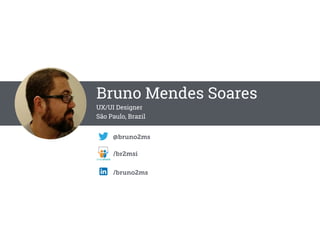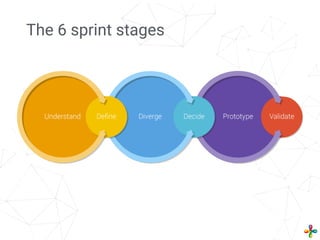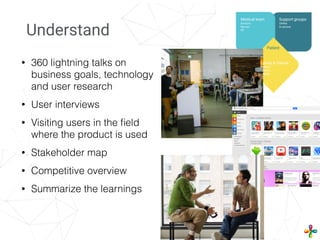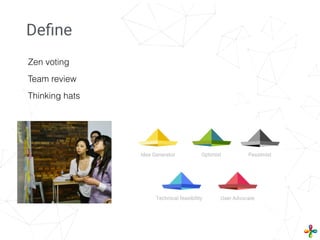Google Design sprint
- 1. THE DESIGN SPRINTS innovating with
- 2. @bruno2ms Bruno Mendes Soares UX/UI Designer São Paulo, Brazil /br2msi /bruno2ms
- 3. Great Design happens within constraints. And those constraints are good because it helps narrow your focus. There`s something about the pressure and, in many cases, conflict that create good things. https://www.youtube.com/watch?v=137XnWlUTKY
- 4. The Design Sprints are a 2-5 days process for answering critical business questions through design, prototyping, and testing ideas with customers. #businessstrategy #innovation #sprints #behaviorscience #designthinking Mix of ideas from the Agile framework, and the idea of design thinking. What is this?
- 5. The sprint gives teams a shortcut to learning without building and launching.
- 7. THE SPRINT MASTER A Sprint Master is the lead of the team. Leaders who have deep knowledge of the design process and are not afraid to challenge their team to collaborate and win together quickly. Identifies the design challenge; brings the team together; takes them all sprint stages; facilitate the process; Roles
- 8. Sprint Master Workflow Before the sprint During the sprint After the sprint
- 9. Sprint Master Workflow Before the sprint During the sprint After the sprint Write a design brief ● Define challenge ● Timeline to launch Invite the team Schedule lightning talks Schedule user testing Prepare a facilitator’s deck Prepare the room Prep the space Facilitate Appoint leaders Course correct Resolve conflicts Daily check ins Daily email summary Celebrate Create a path to launch Document Summary email Survey to sprinters Next sprint planning
- 10. The 6 sprint stages
- 11. The 6 sprint stages Understand: What are the user needs, business need and technology capacities? Define: What is the key strategy and focus? Diverge: How might we explore as many ideas as possible? Decide: Select the best ideas so far. Prototype: Create an artifact that allows to test the ideas with users. Validate Test the ideas with users, business stakeholders and technical experts. Validate Test the ideas with users, business stakeholders and technical experts.
- 12. Understand Expertise and knowledge on most teams is asymmetrical: Sales knows things engineering doesn’t, customer support knows things design doesn’t, and so on.
- 13. • 360 lightning talks on business goals, technology and user research • User interviews • Visiting users in the field where the product is used • Stakeholder map • Competitive overview • Summarize the learnings Understand
- 14. • Summarize the learnings and first ideas. • Share your thoughts. • Group ideas. • Vote on the best ideas Understand
- 15. Define Create a simple user story, set the scope for the week, and take useful notes as a team.
- 16. User journeys: a map that lists all the stages that someone goes through from learning about the product to becoming an expert user. Design principles: What 3 words would you like for users to describe your product? First tweet: What is the first announcing tweet you will send out Define
- 17. Diverge By breaking it down into four discrete steps (Notes, Mind Map, Crazy 8s, and Storyboard), we show you how CEOs, engineers, and sales folk alike can contribute their ideas effectively.
- 18. Sketch 8 ideas in 5 minutes: the team is starting to warm up Sketch 1 idea in 5 minutes: understanding the details better Sketch 1 storyboard in 5 min: understanding the steps Define
- 19. Decide After sketching, you’ll use a structured critique and weighted voting to select the best ideas from the field of possibilities.
- 20. Zen voting Team review Thinking hats Define
- 21. Prototype Like George Clooney in Ocean’s Eleven, you’ll gather a team of experts, assign roles, and put your plan into motion. And just like in the movie (sorry, spoiler alert), you’ll get the job done and still have time to enjoy your evening.
- 23. Validade Obviously, when a risky idea succeeds, it’s a fantastic payoff. But it’s actually those epic failures which, while painful to watch, provide the greatest return on investment. When a prototype flops, it means we’ve spotted critical flaws after only five days of work.
- 24. User test A simple user test can uncover valuable insights very quickly Stakeholder feedback Let the key stakeholder of the projects decide how to fund or allocate resources to the ideas. Technical feasibility check Do the design ideas match or exceed the technical capacity of the team? Validate
- 25. HAVE A GREAT SPRINT!
- 27. @bruno2ms Bruno Mendes Soares UX/UI Designer São Paulo, Brazil /br2msi /bruno2ms



























